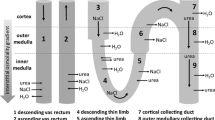Summary
To clarify the question whether solute and water fluxes between pelvic urine and the renal papilla contribute to the medullary accumulation of osmotically active substances and thus to final urine concentration, we measured the osmolarity of urine samples from the papillary tip of rat kidneys during superfusion of the exposed papillae with solutions of widely varying osmotic concentrations. When the osmolarity of the superfusion fluid consisted half of urea and half of sodium chloride, urine osmolarity was observed to change parallel to the bath solution over a certain concentration range (800–2000 mosm/l). The changes of urine concentration occurred within 90 min after the start of the papillary superfusion. Similar results were obtained when the sodium chloride concentration was kept constant at 300 mosm/l and the urea concentration varied to yield bath concentrations up to 3000 mosm/l. A rise of urine concentration by papillary superfusion above 2000 mosm/l was achieved when exogenous arginine-vasopressin was infused intravenously suggesting that the failure of urine concentration to equilibrate with the bath concentration was due to a limited water permeability of the collecting ducts. These results suggest that solute and water fluxes between pelvic urine and the renal papilla are a necessary prerequisite to achieve maximal osmotic urine concentrations. In addition, such fluxes may explain the variability of medullary tissue concentrations under various diuretic states.
Similar content being viewed by others
References
Atherton, J. C., Green, R., Hai, M. H.: The time course of changes in renal tissue composition during water diuresis in the rat. J. Physiol. (Lond.)197, 429 (1968).
Berliner, R. W., Bennett, C. M.: Concentration of urine in the mammalian kidney. Amer. J. Med.42, 777 (1967).
Bray, S. A., Preston, A. S.: Effect of urea on urine concentration in the rat. J. clin. Invest.40, 1952 (1961).
Davis, J. M., Schnermann, J.: Effect of antidiuretic hormone on the distribution of nephron filtration rates in rats with hereditary diabetes insipidus. Pflügers Arch.330, 323 (1971).
Gertz, K. H., Schmidt-Nielsen, B., Pagel, H. D.: Exchange of water, urea and salt between the mammalian renal papilla and the surrounding urine. Fed. Proc.25, 327 (1966).
Hai, M. A., Thomas, S.: The time-course of changes in renal tissue composition during lysine vasopressin infusion in the rat. Pflügers Arch.310, 297 (1961).
Horster, M., Thurau, K.: Micropuncture studies on the filtration rate of single superficial and juxtamedullary glomeruli in the rat kidney. Pflügers Arch. ges. Physiol.301, 162 (1968).
Netter, H.: Theoretische Biochemie, S. 74. Berlin-Göttingen-Heidelberg: Springer 1959.
Pfeiffer, E. W.: Ecological and anatomical factors affecting the gradient of urea and non-urea solutes in mammalian kidneys. In: Urea and the kidney, p. 358. B. Schmidt-Nielsen and D. W. S. Kerr, eds.; Amsterdam: Excerpta Medica Foundation 1970.
Saikia, T. C.: The acute effect of vasopressin upon the composition of the rat renal cortex and medulla. Quart. J. exp. Physiol.50, 146 (1965).
Schmid-Schönbein, H., Wells, R., Goldstone, J.: Influence of deformability of human red cells upon blood viscosity. Circulat. Res.25, 131 (1969).
Thurau, K., Deetjen, P., Kramer, K.: Hämodynamik des Nierenmarks. II. Mitteilung. Wechselbeziehung zwischen vasculärem und tubulärem Gegenstromsystem bei arteriellen Drucksteigerungen, Wasserdiurese und osmotischer Diurese. Pflügers Arch. ges. Physiol.270, 270 (1960).
Ullrich, K. J., Drenckhahn, Jarausch, K. H.: Untersuchungen zum Problem der Harnkonzentrierung und Verdünnung. Pflügers Arch. ges. Physiol.261, 62 (1955).
Valtin, H.: Sequestration of urea and non-urea solutes in renal tissues of rats with hereditary hypothalamic diabetes insipidus: effect of vasopressin and dehydration on the countercurrent mechanism. J. clin. Invest.45, 337 (1966).
Author information
Authors and Affiliations
Additional information
This work was supported by the Deutsche Forschungsgemeinschaft
Rights and permissions
About this article
Cite this article
Schütz, W., Schnermann, J. Pelvic urine composition as a determinant of inner medullary solute concentration and urine osmolarity. Pflugers Arch. 334, 154–166 (1972). https://doi.org/10.1007/BF00586788
Received:
Issue Date:
DOI: https://doi.org/10.1007/BF00586788




